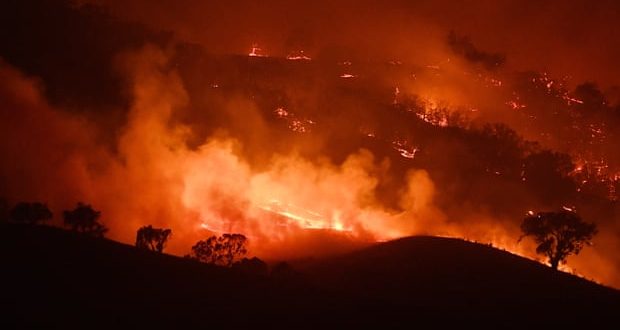Apocalyptic scenes give glimpse of what would be normal conditions in 3C world
The bushfires ravaging Australia are a clear sign of what is to come around the world if temperatures are allowed to rise to dangerous levels, according to scientists.
“This is what you can expect to happen … at an average of 3C [above pre-industrial levels],” said Richard Betts, professor of geography at Exeter University. “We are seeing a sign of what would be normal conditions in a 3C world. It tells us what the future world might look like. This really brings home what climate change means.”
Average temperature rises in Australia were about 1.4C above pre-industrial levels before this season’s fires, showing a more rapid rate of heating than the global average of 1.1C.
Scientists warn that beyond a rise of 2C, the impacts of climate breakdown are likely to become catastrophic and irreversible, yet current global commitments to cut greenhouse gas emissions under the Paris agreement are estimated to put the world on track for 3C of heating.
“These are the impacts we are seeing at 1C [of heating] so these impacts will get more [severe] as long as we do not do what it takes to stabilise the world climate,” warned Corinne Le Quéré, professor of climate change science and policy at the University of East Anglia (UEA). “This is not a new normal – this is a transition to more impacts.”
Global heating has led to an increase in the frequency and severity of fire weather – the conditions in which wildfires are likely to start – around the world, a review of 57 recent scientific papers has shown.
But land management to try to minimise fires had helped to reduce the number that would have been expected in Australia, said Matthew Jones, a research associate at UEA. “Climate change increases the frequency and severity of fire weather across the globe but humans have moderated how this risk translates into fire. Land management has reduced the incidence of fire globally.”
He said efforts to regrow forests after the fires have subsided would also help, by taking up the carbon dioxide from the atmosphere that has been emitted as a result of the fires, though this would take decades of new tree growth.
The area of land burned around the world has decreased in recent years, the study found, largely owing to the clearing of savannahs for agriculture and people suppressing fires. More fires are also erupting in closed canopy forests, which is of particular concern as they are likely to result from forest degradation and climate breakdown.
In Australia, while recent rains have offered limited hope in some areas, there is not likely to be much greater relief in the next two months, according to Betts. While the Indian Ocean dipole weather system – which has brought hotter and drier conditions to Australia – has now passed its peak, weather systems in the eastern Pacific, which have brought hotter temperatures to Australia, are likely to continue and could result in continued hot and dry weather through January and February.
Betts said the extreme bushfires in Australia showed what climate change would mean in reality, which many people found hard to imagine. The influence of human-induced climate change was clear in the Australian fires, he said, though more studies were likely to confirm this in the coming months.
The UEA will produce a study on carbon cycle feedbacks before the COP26 UN climate conference in Glasgow in November, when countries are expected to give stronger commitments on greenhouse gas emissions to fulfil the aims of the 2015 Paris agreement.
The Guardian
 Lebanese Ministry of Information
Lebanese Ministry of Information



